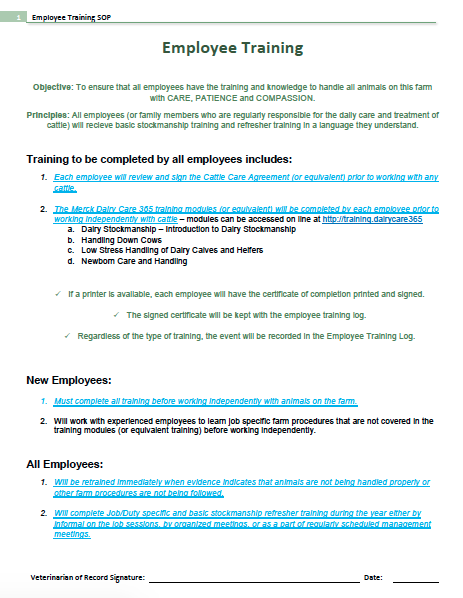Personnel Training
Written protocols should be in place and reviewed annually with your veterinarian and employees to ensure that certain procedures are carried out appropriately.
Goal:
To ensure all employees have the training and knowledge to handle all animals with care, patience, and compassion.
How to assess:
Review the personnel training protocol to confirm that the following information is included and that appropriate criteria are being met:
Dairy Well
- Prior to the start of work with cattle and before working independently, all employees must:
- Sign a Cattle Care Agreement
- Complete Merck Dairy Care 365 training modules (or equivalent)
- Employees must be retrained immediately when there is evidence that animals are not being handled properly
- Continuing employees must receiver refresher training during the year
- Signed by VOR
How to Assess: Employees will be evaluated to be sure that cows are moved calmly and quietly without excessive force (using physical tools, yelling, kicking, hitting, chasing, , spraying water in the face, excessive twisting of tails, etc.)
- Critical Criteria; acts of abuse will not be tolerated
- If caregivers are yelling or moving cows quickly or forcefully such that it causes slips and falls, or if they are hitting or kicking cows, this is unacceptable stockmanship and results in critical non-conformance
- Hitting = when an arm swings back behind the frontal plane of the body and then forward, or is lifte above shoulder level and then down
- Kicking = when a leg is swung back behind the frontal plane of the body and then forward
- If caregivers are yelling or moving cows quickly or forcefully such that it causes slips and falls, or if they are hitting or kicking cows, this is unacceptable stockmanship and results in critical non-conformance

A template is provided as a guideline; farms may write their own as long as minimum content is met.
National Dairy FARM Program
- Documentation of training in:
- Stockmanship - for all employees with animal care responsibilities
- Calf care: nutritional requirements, feeding techniques and proper handling and movement - for all employees with calf care responsibilities
- Non-ambulatory animal management - for all employees with non-ambulatory animal responsibilities
- Euthanasia - for employees designated to euthanize animals
Validus
- Written animal handling protocol gives clear directives to not break tails or ear twisting when moving animals
- Facility has an animal welfare policy that caretakers have been trained to
- Include directives that any occurrence of willful abuse or neglect must be reported immediately
- Documented record of the animal welfare policy/cow care agreement signed and dated by caretakers prior to the start of work
- Caretakers are aware of consequences for animal abuse
- Non-employees (contractors, foot trimmers, drivers, etc.) sign animal care protocol forms
- Written training records verify caretaker training, including date, topic, trainer, and signature of trainee
- Animal husbandry skills
- Animal handling procedures
- Process to follow when introducing new animals; appropriate tools for movement (flags, gates, flight zones)
- Emergency procedures
- Movement of non-ambulatory animals
- Hospital area management
- Euthanasia management
- Protocols are written and posted prominently in native worker language




